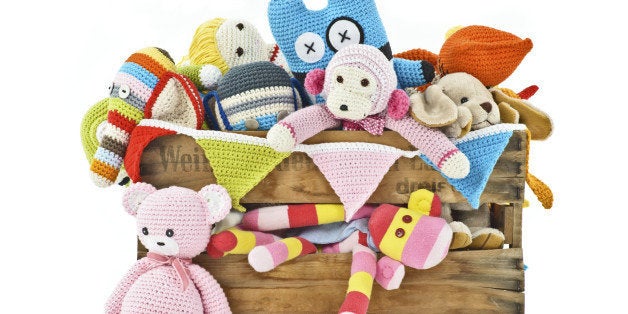
By Renee Bock
There's no such thing as a girl's toy or a boy's toy. Many boys like pink and, of course, girls like blue. Girls build with blocks, they play with worms, and they love to dress up as super heroes. Boys draw princesses, they read Pinkalicious, play with dolls, and they like to cook. Their diversity of interest defines what it means to be human and its what's incredible about childhood.
With the holiday season -- and holiday shopping -- upon us, it's worth thinking about the gifts you buy through the lens of childhood education and social development. Especially in light of Target's announcement earlier this year to "identify areas where we can phase out gender-based signage to help strike a better balance... signs will no longer feature suggestions for boys or girls, just kids."
If Target stays true to its promises, this holiday season you won't find pink, blue, yellow or green on the back walls of shelves. The store will still sell Barbie and GI Joe, only you won't find them separated in the boys or girls aisle. People will have to purchase with intention according to children's interest.
As a long-time preschool educator and mother of three, I applaud this decision which struck me as non-controversial and long overdue. And yet, when Target announced the change on their website, the store received a highly critical public response. "Target made a mistake," "I'll no longer shop there," "They're too PC," "The transgender minority is behind this," etc. I think we should put all of this in perspective.
Babies come into the world ready to learn, every minute of every day. They learn from their environment, from the words they hear at home, and ultimately the culture in which they are raised. Marketing drives perception and behavior of the adults who will fill baby's world with things, and those things, in turn, will impact a child's perception of self, as well as their interests. In the consumer society, that cycle begins at birth and has a powerful impact on defining and leading gendered play at home, on the playground and even in school.
New parents, relatives without kids, and children themselves are vulnerable consumers. The girl who likes to play with Legos in school might select a doll in the store simply because Mommy only walks down the pink aisle. The boy who likes to string beads and paint at camp might never signal that interest to grandma who is walking only down the blue aisle. Unlike teachers who get to know so many children over a career that the exceptions define the norm, most consumers are at the mercy of the market.
The gendered system of signage limits and leads in unnecessary ways, ways that can ultimately make a child question their natural attractions if they go against the assumptions of the surrounding world and thereby narrow a life's path. The beauty of an early childhood classroom, however, is that all experiences, from mud pies to decorating birthday crowns, are open to everyone. How absurd would it be if the block area had signage in blue, beckoning only the boys with pictures of boys! What if the dollhouse area made visual appeal to girls alone? We wouldn't stand for it because parents and teachers in a school context are more aware that children need access to a very wide range of experiences in order for their brains, and singular personalities to grow. We celebrate the openness that invites children to explore options.
I hope that Target's recent decision opens new territory for play at home. In the shift away from gendered signs, Target is advocating for kids to be kids. The store is forcing parents to pay attention and purchase with intention according to the individual child's interests. Look more closely, find that special something that really speaks to your child, follow their lead and transcend predictive shopping that limits possibilities now and in the future. Remember that color has no particular appeal to boys or girls, and think twice about how you make purchasing decisions for your children through this holiday season and beyond.
More from Well Rounded NY:
10 Tips for Flying with Baby
Discipline Decisions with a Toddler
Addressing your Toddler's Sleep Crutches
This piece was originally published by Renee Bock. Renee Bock is a dedicated early childhood educator, who is currently the Chief Academic Officer at Explore+Discover, a social learning center in Manhattan that is committed to setting the standard for infant and toddler care and education. Renee has more than a decade of experience in the field and holds a Master's in Early Childhood Education from Bank Street College in New York. She has three sons, Ariel (15), Raffi (14), and Shaya (12). She can be reached at rbock@explorediscover.net.
Please share your opinion below! For more original content, check out Well Rounded NY.
Follow Well Rounded NY on Twitter
Follow Well Rounded NY on Twitter:https://twitter.com/WellRoundedNY